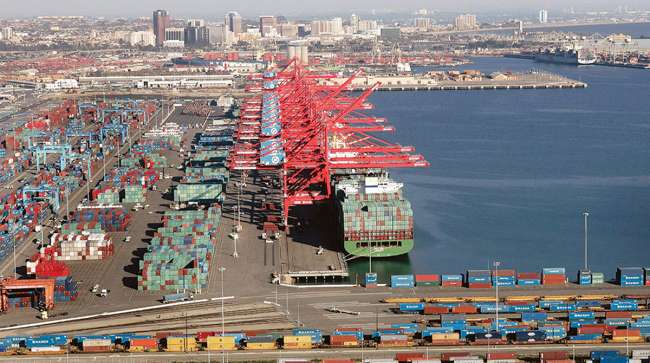Senior Reporter
White House Unveils FLOW Plan to Improve Supply Chain

[Stay on top of transportation news: Get TTNews in your inbox.]
In an effort to open up the nation’s clogged supply chains, the Biden administration on March 15 announced plans for a pilot program under which organizations across the transportation landscape would share data with one another to improve the overall flow of goods.
Called Freight Logistics Optimization Works or FLOW, the Ports of Los Angeles and Long Beach are among the first to agree to participate. Also pledging support is the Georgia Ports Authority.
The White House said the program is needed because “the lack of digital infrastructure and transparency makes our supply chains brittle and unable to adapt when faced with a shock.” While acknowledging the need for various companies to provide information without revealing proprietary information, the White House said the current lack of information exchange “can cause delays as cargo moves from one part of the supply chain to another, driving up costs and increasing goods movement fragility.”
Transportation Secretary Pete Buttigieg said the initiative’s goal could reap benefits across industries. “If it doesn’t work on a handshake it doesn’t work,” Buttigieg said. “Nobody can command this kind of sharing, but we also know it needs to happen.”

Cordero
“With better information we can speed things up,” Port of Long Beach Executive Director Mario Cordero told Transport Topics. “For trucking, it will help the distribution of how we move cargo. We can improve the overall flow of goods.” He added, “Things are getting better, but it’s a work in progress.”
The administration said it hopes to get the participation needed to build out the data exchange by the end of summer.
It’s not uncommon for a piece of cargo to change hands 10 or more times from a truck at an overseas port to an eventual delivery at a retail store or on someone’s doorstep, experts said.
“Supply chains are both complex and are relatively simple, so long as something doesn’t disrupt them,” University of Minnesota-Morris economist and professor Stephen Burks told TT. “For the past two years, because of COVID, many people went home and worked from home. But since that time, all the disruption has been because final demand increased and a lot more consumer goods — compared to services — were being consumed. It’s the extra demand which caused the issues we’re seeing.”
Last June, President Joe Biden created a supply chain task force to study structural supply chain problems that must be addressed. The current surge of freight is expected to continue at a record pace for at least the next 10 years, and industry experts say the country desperately needs to upgrade ports, roads, bridges, rail systems and build thousands more warehouses to handle the volume.
“Now is the time to begin investing,” Cordero said. “I’m very optimistic. We’ve gone through a lot of tragic things with the global health pandemic, but a crisis brings opportunities. The supply chain prior to COVID was fragile, but we’re getting investment from Washington, D.C., and Sacramento.”
Want more news? Listen to today's daily briefing above or go here for more info
As part of the $1.2 trillion infrastructure bill Biden signed last year, the nation’s ports are expected to receive at least $17.2 billion in federal funding for revitalization. Plus, ports in California will receive $250 million in COVID-19 relief money to reimburse them for losses they incurred as a result of the pandemic.
Looking ahead, the National Retail Federation is forecasting strong consumer spending in 2022, with both online and brick and mortar retail outlets looking at year-over-year growth between 6% and 8%, totaling as much as $4.95 trillion. The new projections, announced March 15, do not include automobile dealers, gas stations and restaurants. Year-over-year, nonstore and online sales, which are included in the total $4.95 trillion figure, are expected to grow between 11% and 13% to $1.17 trillion to $1.19 trillion as consumers continue to drive growth in e-commerce.

Shay
“NRF expects retail sales to increase in 2022, as consumers are ready to spend and have the resources to do so,” NRF CEO Matthew Shay said. “We should see durable growth this year given consumer confidence to continue this expansion, notwithstanding risks related to inflation, COVID-19 and geopolitical threats.”
While the 2022 forecast is lower than 2021’s record 14% annual growth rate, the new number is still well above the 10-year, pre-pandemic average retail growth rate of 3.7% annually.




